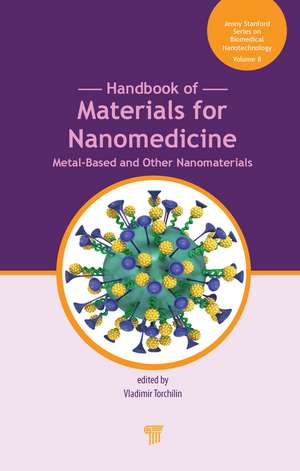Handbook of Materials for Nanomedicine: Metal-Based and Other Nanomaterials: Jenny Stanford Series on Biomedical Nanotechnology
Editat de Vladimir Torchilinen Limba Engleză Hardback – 16 mar 2020
| Toate formatele și edițiile | Preț | Express |
|---|---|---|
| Hardback (3) | 1095.85 lei 43-57 zile | |
| Jenny Stanford Publishing – iul 2020 | 1095.85 lei 43-57 zile | |
| Jenny Stanford Publishing – 16 mar 2020 | 1100.18 lei 43-57 zile | |
| Jenny Stanford Publishing – 15 iun 2020 | 1395.24 lei 43-57 zile |
Preț: 1100.18 lei
Preț vechi: 1472.17 lei
-25% Nou
Puncte Express: 1650
Preț estimativ în valută:
210.51€ • 220.39$ • 174.19£
210.51€ • 220.39$ • 174.19£
Carte tipărită la comandă
Livrare economică 07-21 aprilie
Preluare comenzi: 021 569.72.76
Specificații
ISBN-13: 9789814800938
ISBN-10: 9814800937
Pagini: 554
Ilustrații: 158
Dimensiuni: 152 x 229 mm
Greutate: 1.18 kg
Ediția:1
Editura: Jenny Stanford Publishing
Colecția Jenny Stanford Publishing
Seria Jenny Stanford Series on Biomedical Nanotechnology
ISBN-10: 9814800937
Pagini: 554
Ilustrații: 158
Dimensiuni: 152 x 229 mm
Greutate: 1.18 kg
Ediția:1
Editura: Jenny Stanford Publishing
Colecția Jenny Stanford Publishing
Seria Jenny Stanford Series on Biomedical Nanotechnology
Public țintă
Academic and Professional Practice & DevelopmentCuprins
Hybrid Gold Nanoparticles. Gold Nanoparticles in Cancer Therapy. Silver Nanoparticles in Medicine. Surface-Modified Magnetic Nanoparticles in Medicine. Magnetic Nanoparticles in Theranostics. Activatable Fluorescent Quantum Dots. Lipid Bubbles and Ultrasound for Drug Delivery. Nanobubbles: State of the Art, Features, and the Future. Materials for Nanoemulsions and Their Influence on the Biofate. Nanocrystals: The Universal Formulation Principle to Improve the Bioactivity of Poorly Soluble Actives. Cellular and Molecular Toxicology of Nanoparticles.
Notă biografică
Vladimir Torchilin is University Distinguished Professor of pharmaceutical sciences and the Director of the Center for Pharmaceutical Biotechnology and Nanomedicine at Northeastern University, USA. His research interests include drug delivery and targeting, nanomedicine, multifunctional and stimuli-sensitive pharmaceutical nanocarriers, biomedical polymers, experimental cancer therapy, cancer immunology, and novel imaging agents. He has published more than 450 original papers, more than 150 reviews and book chapters, and 12 books and holds more than 40 patents. Google Scholar gives more than 66,000 citations of his work with H-index of 114. Prof. Torchilin is editor-in-chief of Drug Delivery and Current Drug Discovery Technologies and is on the editorial boards of several leading journals in the field, including Journal of Controlled Release (review editor), Bioconjugate Chemistry, Advanced Drug Delivery Reviews, European Journal of Pharmacehzutics and Biopharmaceutics, Journal of Drug Targeting, Molecular Pharmaceutics, and Journal of Biomedical Nanotechnology. He is also a Full Member of the European Academy of Sciences and Fellow of the American Institute of Medical and Biological Engineering, American Association of Pharmaceutical Scientists (AAPS), and the Controlled Release Society. He is a recipient of the 1982 Lenin Prize in Science and Technology (the highest scientific award in the former USSR), the 2005 Research Achievements in Pharmaceutics and Drug Delivery Award from the AAPS, 2007 Research Achievements Award from the Pharmaceutical Sciences World Congress, 2009 AAPS Journal Award, 2009 International Journal of Nanomedicine Distinguished Scientist Award, 2010 Controlled Release Society Founders Award, 2012 Life Time Achievements Award from the Journal of Drug Targeting, 2012 Alec Bangham Life Time Award, and 2013 Blaise Pascal Medal for Biomedicine from the European Academy of Sciences.
Descriere
This book presents the advances in the use of lipid-based and inorganic nanomaterials for medical imaging, diagnosis, theranostics, and drug delivery. The materials discussed include liposome-scaffold systems, elastic liposomes, targeted liposomes, solid lipid nanoparticles, lipoproteins.





